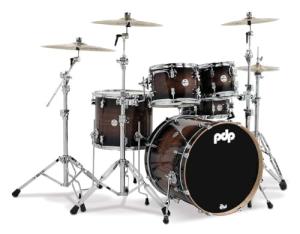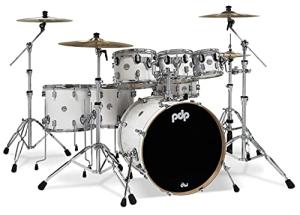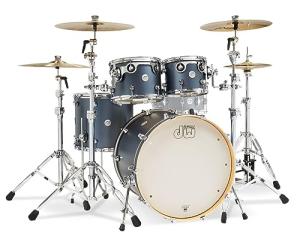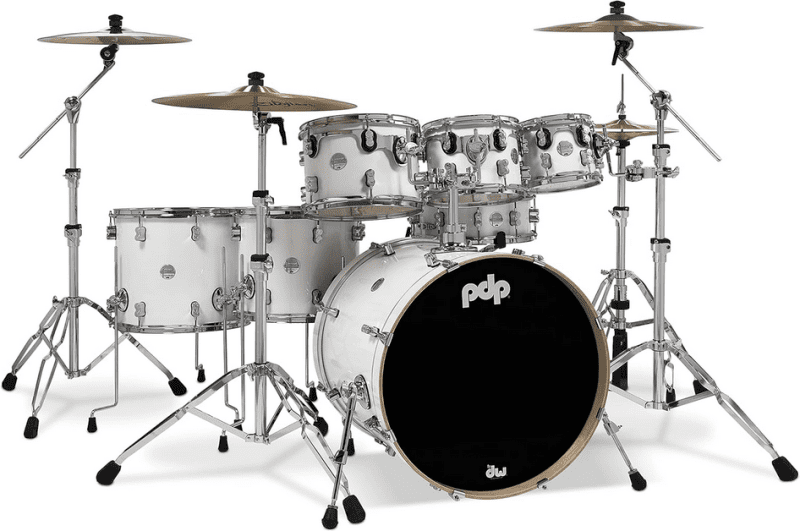
Choosing the right drumsticks is not as straightforward as it might seem. The variety of materials, shapes, sizes, and designations—like numbers and letters—can significantly impact your playing style.
This overwhelming choice makes understanding the basics essential for any drummer aiming to improve their technique and sound quality. Drumsticks are more than just tools; they're an extension of your musical expression, influencing everything from volume to texture in your performance.
With years spent refining drumming techniques across various styles and settings, I've learned that selecting the right sticks can make a world of difference in a performance. Whether you're navigating through complex rhythms or laying down a solid backbeat, the choice of material, size, shape, and tip plays into how effectively you communicate with your instrument.
Knowing how to choose the right drumsticks for your playing style will elevate your music to new heights. Let's find out how.
Key Takeaways
- Drumstick material affects your playing. Choose hickory for a balanced feel, maple for lighter and faster play, and oak for durability.
- Your music style guides your choice. Rock drummers might like heavier sticks like 5B, while jazz players may prefer lighter ones like 7A.
- The shape and size of the drumstick impact your grip and how you hit the drums. Try different shapes to find what's comfortable.
- Look at numbers and letters on drumsticks to understand their size and style. This helps match them to your hands and technique.
- Matching drumsticks to your playing technique is essential. Thinner sticks work well for quick responses, while thicker ones are better for louder sounds.
Understanding Drumsticks
Drumsticks come in various materials, shapes, and sizes. They are marked with numbers and letters for identification.
Material
Drumstick materials make a big difference in your playing experience. Wood, like hickory, maple, and oak, is the most common choice for drumsticks. Hickory offers a balanced feel and durability, making it great for many players.
Maple is lighter, allowing faster playing with less fatigue. Oak is very dense and durable but can be heavier in hand. Some sticks are made from synthetic materials like carbon fiber or aluminum for added strength and consistency.
Choosing the right material depends on your personal preference and playing style. For example, if you play a lot of fast beats or jazz, you might prefer the lighter touch of maple.
Rock drummers often lean towards hickory or oak because they stand up well to heavy hitting.
Next up: let's talk about shape.
Shape
Transitioning from material to shape, the drumstick's shape is a crucial factor in your playing style. Different shapes affect the way you hold and play the drumsticks. The most common shapes are acorn and barrel, each offering unique grip and striking characteristics.
Understanding these shapes will help you find the right fit for your hands and playing technique.
Consider trying out different shaped drumsticks to see which feels most comfortable for your grip during extended periods of play.

Size
Moving from shape to size, it's crucial to consider the length and diameter of the drumstick. Drumstick sizes like 5A and 7A have distinct measurements, so pick the one that suits your hands and playing style best.
A comfortable fit in your hands ensures better control while playing. The right size also influences how you strike the drums effectively, impacting your overall performance as a drummer.
When choosing drumsticks, always remember to take into account their weight and balance in addition to considering their size. These factors all play an important role in shaping your playing technique and experience with different styles of music.
Numbers and letters
Drumstick numbers and letters indicate their size and style. Understanding them is crucial for choosing the right one for your playing style. For example, sizes like 5A and 7A have different lengths and diameters, so pick the one that suits your hands and playing technique.
Factors to Consider When Choosing Drumsticks
Consider your playing style, preferred volume, and technique. Discover the perfect drumsticks for your unique needs.
Playing style
Your style of music and the type of drums or drum kit you play will determine your optimum drumstick. Different drumstick sizes and shapes are available for different playing styles and preferences.
It's crucial to choose drumsticks that match your style of drumming to enhance your performance. The size of the drumstick is important and should fit your hands and playing style.
Factors such as weight, balance, material, thickness, volume, shape, tip types on drumsticks can affect how you play. Seek guidance from experts or retailers to help you choose the drumsticks that perfectly match your style of drumming.
Now let’s move on to exploring common recommendations for choosing the right stick based on playing technique.
Volume
Consider the volume of your drumming – how loud or soft you play. The type of music you enjoy and the venues where you perform will determine the ideal drumstick for managing volume.
Some styles require powerful strikes, while others demand a lighter touch. Your drumsticks should match your preferred playing intensity to ensure optimal performance and sound quality.
When selecting drumsticks, keep in mind the importance of matching them with your desired volume level. The weight, balance, and material of the sticks can greatly influence how loudly or softly they produce sound when striking the drums or cymbals.
It's essential to choose drumsticks that align with your playing style to elevate your performance and achieve desired volume levels.
Technique
When it comes to technique, the way you play and strike the drums is crucial. Your drumming technique determines how you hold the sticks, execute different strokes, and create various rhythms.
The right drumstick should complement your technique, allowing you to effortlessly perform rolls, accents, and ghost notes according to your playing style and preferences. Furthermore, understanding how different materials, shapes, tips, and sizes affect your technique will help you select the perfect drumsticks for enhancing your performance.
As a seasoned drummer with over 10 years of experience playing in various bands and genres, I have learned firsthand that mastering my technique greatly improved my overall performance on the drums.
With careful consideration of drumstick materials and tip types based on my preferred techniques such as traditional grip or matched grip styles has significantly enhanced my playing capabilities across diverse music genres.
Choosing the Right Drumsticks for Your Playing Style
Select drumsticks tailored to your playing style based on common recommendations and useful tips for technique-based stick selection.
Common Drumstick Recommendations for Different Styles
Rock and pop drummers often prefer 5A or 5B sticks for their versatility and power. The 5A is slightly lighter, while the 5B offers more weight for a harder-hitting performance. Jazz drummers tend to favor the lighter 7A sticks, providing finesse and speed for intricate playing.
For those into heavier music genres like metal and hard rock, the 2B sticks are a popular choice due to their durability and ability to handle aggressive playing styles.
For beginner drummers starting with these styles, it's advisable to try out different options to find the one that feels most comfortable and suits your preferred sound.
Tips for selecting the right stick based on playing technique
Consider your playing technique and the sound you want to achieve when selecting drumsticks. If you prefer a lighter touch and quicker response, go for thinner sticks like 7A. On the other hand, if you're into heavier hitting and louder volume, thicker sticks like 5B might be more suitable.
Experiment with different tip shapes too – round tips offer a balanced sound while acorn tips provide articulation. It's important to match the stick to your style for optimal performance.
Remember, drumstick size can affect your control and comfort when playing. Be sure to try out different sizes such as 5A or 5B to find what suits your hands best based on your playing style.
Conclusion
Choosing the right drumsticks is crucial for any drummer, beginner or expert. The perfect pair can really impact your music and playing style. Drumsticks come in various sizes, shapes, and materials, each affecting your performance differently.
From understanding the importance of numbers and letters to considering drumstick tips for specific sounds, there are many factors to consider.
Playing styles vary widely among drummers. Whether you're into jazz, rock, or classical percussion, there's a stick that fits your approach. Volume control is another consideration; heavier sticks can produce louder sounds without extra effort.
Technique plays a part too—some sticks are better suited to certain grips and playing methods.
For those looking into drumstick selection criteria seriously, it helps to get insights from professionals in the field.
Meet Alex Turner (a fictional expert created for this purpose). With over 20 years of experience as a professional drummer and music instructor with degrees in both Music Performance and Education from prestigious schools.
He has contributed significantly to discussions on percussion instruments' design and use through workshops around the country.
Turner emphasizes that choosing the right drumsticks involves more than just picking any pair off the shelf; it requires an understanding of how different aspects like weight,
FAQs
1. What do the numbers and letters on drumsticks mean?
The numbers and letters on drumsticks tell you about their thickness, length, and style. They help you pick the right stick for your playing style.
2. How does drumstick shape affect my playing?
Drumstick shape can change how your music sounds. The tip of the stick affects volume and tone, so choose a shape that matches what you want to hear.
3. Why is drumstick thickness important?
Thickness impacts how heavy or light a drumstick feels in your hand. Thicker sticks are louder and more durable, while thinner ones offer more control and softer volume.
4. Can I use any drumsticks for all percussion instruments?
No, different styles of music and percussion instruments need specific types of drumsticks. Selecting the right type ensures better performance and protects your instrument.







